
Day 1
Xi'anWe will receive you from the airport and check you into the hotel.
Day 2
Xi'an-

- The Terra-cotta Warriors and Horses
Today we will visit the Terra-cotta Warriors and Horses, the Bell Tower and the Wild Goose Pagoda. We will enjoy the Tang Dynasty show in the evening.
The Terra-cotta Warriors and Horses: This is one of the greatest archaeological findings of the 20th century - the army of terra-cotta warriors and the bronze chariots entombed in vast underground vaults at emperor Qin Shi Huang's tomb from two thousand years ago. It is a sight not to be missed by any visitor to China. Emperor Qin Shi Huang ascended to the throne of Qin at the age of 13 in 246 BC. Under him, Qin conquered the other six warring states and became the first true emperor, or Shi Huang, of China.
The Bell Tower: This is the emblem of Xian city. It was used to keep time for the town and to sound alarms. This huge tower was originally built in the 14th century, and was relocated in 1739.
Big Wild Goose Pagoda: The Big Goose Pagoda is where the renowned Buddhist Master Xuanzang (Monk Tripitaka) stored his classics brought back all the way from India. The pagoda is one of the oldest structures in China. Originally it consisted of a brick structure of five storeys and was about 60 meters high. It was first built in 589AD during the Sui Dynasty. Between 701AD and 704AD during the reign of the Empress Wu Zetian five more storeys were added to the pagoda making it ten in all.
The Tang Dynasty show: This is the show that presents the palace dances and songs from the Tang Dynasty (618AD-907AD) when Xian was the capital of China.
Day 3
Xi'an-

- The Ancient City Wall
After breakfast we will visit the Shaanxi historical museum, the Xian City Wall. Then we will transfer you to the airport to take the flight to Urumqi, and we will check you into the hotel upon your arrival there.
Shaanxi History Museum: This provincial museum is one of the major museums in China. It holds numerous unearthed cultural artifacts from within the Shaanxi province as well as the rest of China. It covers 65,000 square meters, with a building area of 60,000 square meters. The newly built modern building recreates Tang-dynasty architecture and successfully symbolizes the great extent of Shaanxi history and its remarkable culture.
The Ancient City Wall: This is the most complete city wall that has survived in China as well being one of the largest ancient military defensive systems in the world. It was enlarged in Ming Dynasty (1368-1644) from the city wall initially built in Tang Dynasty (618 -907). Now it is 12 meters tall, 12-14 meters wide covering 14 kilometers in length with a deep moat surrounding it. The City Wall has corner towers, ramparts, sentry towers, gate towers, battlements and a number of city defensive fortifications with very strong defense capability. You can walk, even cycle on the wall. Its south gate is the largest with a suspension bridge. Most of the tourists choose the south gate for sightseeing.
Day 4
Urumqi-

- Xinjiang Museum
In the morning we will visit the Xinjiang Museum. Then we will transfer you to the airport to take the flight to Kashgar. We will check you into the hotel you're your arrival in Kashgar. You will have the remaining day free to explore the neighborhood at your own leisure.
Xinjiang Museum: The Xinjiang Regional Museum is a large integrated museum and a centre for the collection and study of cultural relics in Xinjiang. The museum was built in 1953, featuring Uighur ethnic internal decor style and has an exhibition hall covering an area of about 7,800 square meters. There are more than 50,000 pieces of various kinds of cultural relics stored in the museum, among them are the ancient mummies represented by the “Loulan Beauty”, manuscripts in Chinese, Karosthi, Qiuci, Yanji, Tibetan, Uighurian and other characters prevailing in ancient western regions of China, as well as silk, wool, cotton and hemp fabrics and folk raiment, etc., all items of great intrigue. The 'Loulan beauty' mummy in particular is a well-preserved mummy from 4000 years ago. It still has a reddish brown skin, thick eyelashes, charming large eyes, and long hair.
Day 5
Kashgar-
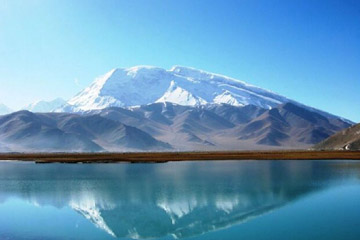
- Karakul Lake
After breakfast we will go to Taxkorgan by coach to visit the White sand lake, and Karakul lake, and we will see the Gaici Fort (passing by).
White Sand Lake: The White Sand Lake is covered by the blown sand, and is always shining in the sunshine. This lake is on the way from Kashgar to the Karakul Lake.
Karakul Lake: At an altitude of 3600m, this is the highest lake of the Pamir plateau, near the junction of the Pamir, Tianshan (Heavenly Mountain), and Kunlun Mountain ranges. Surrounded by mountains which remain snow-covered throughout the year, the three highest peaks visible from the lake are the Muztag Ata (7546m), Konur Tagh (7649m) and Kongur Tiube (7530m). The lake is popular among travelers for its beautiful scenery and the clarity of its reflection in the water, whose color ranges from a dark green to azure and light blue. There are two Kirgiz settlements along the shore of Karakul Lake, a number of yurts about 1 km east of the bus drop-off point and a village with stone houses located on the western shores.
Day 6
Taxkorgan County-
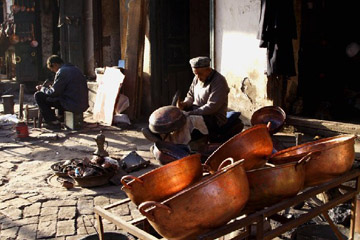
- Handicraft street
After breakfast we will visit the Stone City and then return to Kashgar, to visit the Id Kah Mosque, Handicraft Street and the Old Town.
Id Kah Mosque: This is the largest mosque in China, and the most famous mosque in Xinjiang. The construction of the mosque started in the middle of the 15th century, and the mosque has gradually developed to its present size. The buildings of Id Kah Mosque look magnificent and solemn, and display the artistic styles of Islamic mosque architecture. The Mosque has an area of about 16,800 square meters, consisting of the Pray Hall, the Koran teaching Hall, the Corridor, the Arches and other buildings attaching to it. The Pray Hall of the mosque, which can hold 4,000 prayers, is supported by 140 carved wooden pillars.
Handicraft Street: Handicraft Street, or Zhiren Street, is a fascinating place showing the distinctive custom and culture of Kashgar, with many full-time handicraftsmen working on the street and hundreds of workshops and booths alongside. This street is an exhibition for traditional Kashgar and mid-Asian handicrafts. Copper, metal, porcelain, woodwork, jewellery and other goods are seen to be made here and you will marvel at the incredible devices like the wooden objects that prevent babies from wetting the bed.
Old Town: Kashgar is an ancient city, and in walking the streets of its Old Town, one gets the sense of what this legendary Central Asian hub was like in the days when the Silk Road was at its zenith. 500-year old remnants of the city wall, narrow lanes and colorful multi-ethnic crowds combine to make Kashgar’s historic district a highlight of any visit to the city. Visit the small alleys to look at the characteristic Uygur residences. You will experience and enjoy the culture and history that has been retained in the small alleys and deep courtyards. In the alleys on platforms beside the residence you could marvel at the even more ancient primitive workshops for hand-made earthenware. Some 17 or 18 antique workshops have been restored.
Day 7
Kashgar-
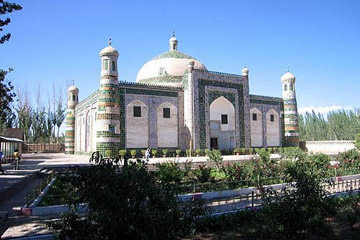
- Apak Hoja Tomb
After breakfast we will visit the Sunday Bazaar, Apak Hoja Tomb, and then take the flight back to Urumqi. We will check into the hotel upon arrival.
Sunday Bazaar: This is called “Sunday” bazaar but it is open daily, even though it is busiest on Sundays. Streets near this big market are jammed with farmers and buyers arriving by donkey cart, truck, bicycle, horseback, ute, motobike, or on foot, with their animals. It is loud, lively and cheerful as they arrive, eat breakfast, set up their animals and check out the action. Cattle, sheep (they definitely look different), goats, donkeys, horses have their own sections. Sellers show off their animals as “good eaters” (most go as livestock, not meat). The entire experience is fascinating and fun.
Apakh Hoja Tomb: This Mazar is the holiest place in Xinjiang for the Muslims, and an architectural treasure. Built in 1640, it is reminiscent of the Central Asian artistic style of Samarkand or Isfahan. The site is also known as the Xiang Fei (Fragrant Concubine) Tomb in memory of Abakh Khoja's granddaughter, Iparhan, who was the Fragrant Concubine of Emperor Qianlong of Qing Dynasty. A handsome blue-and-white tiled gate leads into the compound, which includes a small religious school and the Abakh Khoja family tomb. The latter is domed and faced with muti-color tiles. It is the most complete Islamic tomb dating from the beginning of the Qing Dynasty.
Day 8
Urumqi-

- Heavenly Lake
After breakfast we will head to the Heavenly Lake to enjoy the beautiful scenery there. In the afternoon we will return to Urumqi and visit the Xinjiang International Bazaar.
Heavenly Lake: High up in the Heavenly Mountain, or Tianshan, the Heavenly Lake is a long and narrow gourd-shaped moraine lake, 3400 meters long, about 1500 meters wide, 105 meters at the deepest point, with an average depth of 40 meters, covering an area of about 5.9 square kilometers. To the east of the lake stands the Bogdia Peak-the highest peak in the east part of Tian Shan Mountain, which is capped by glacier and snow glistening in the sun, finely contrasted with blue lake water, forming a fabulous scenery. There are eight beautiful scenic spots in the lake area. These are “A Ray of Stone Gate”, “Dragon's Pool and Green Moon”, “Magic Needle for Guarding the See”, “Three Stones Bearing the Sky”, “the Snowcapped Southern Mountain”, “Pine Billows in Western Mountain”, “the Hanging Waterfall”, and the “Sea Peak's Sunrise”.
Erdaoqiao & International Bazaar: Here you will find a bustling market filled with fruits, clothing, crafts, knives, carpets, and almost anything that you can imagine. This is the largest bazaar in Urumqi, and is a place most welcomed by tourists, especially the ladies who will find they can buy some traditional Yugur cosmetics. On Sunday, there are more stalls and more goods to buy than any other day. The old streets around the bazaar are particularly worth seeing.
Day 9
Urumqi-
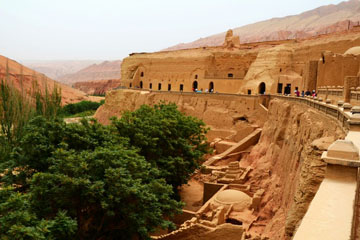
- Bezklik Grottoes
In the morning we will head to Turpan to visit the Bezklik Grottoes, Astana Tombs, and Tuyoq Valley.
Bezeklik Grottoes: The Bezeklik Grottoes, or Thousand Buddha Caves, is a complex of Buddhist cave grottos dating from the 5th to 14th century between the cities of Turpan and Shanshan at the north-east of the Taklamakan Desert near the ancient ruins of Gaochang in the Mutou Valley. They are high on the cliffs of the west Mutou Valley under the Flaming Mountains, and most of the surviving caves date from the West Uyghur kingdom around the 10th to 13th centuries. There are 77 rock-cut caves at the site. Most have rectangular spaces with rounded arch ceilings often divided into four sections, each with a mural of the Buddha. The effect is of entire ceiling covers with hundreds of Buddha murals. Some murals show a large Buddha surrounded by other figures, including Turks, Indians and Europeans. Some of the murals are masterpieces of religious art.
Astana Tombs: This is the graveyard of the residents who lived in the Gaochang City in the Jin-Tang period. Between 1959 and 1975, a great number of cultural relics had been unearthed, including Chinese documents, textiles, epitaphs, coins, clay sculptures, pottery, wooden wares, silk-paintings, crops and foods, etc. The site is known as the Underground Museum.
Tuyoq Valley: This is a 12 km long primitive Uighur agricultural valley about 70 km from Turpan, with vineyards and fields in the northern and southern valleys and a narrow ravine that connects them. It is a Muslim religious pilgrimage site. The southern mouth of the valley has big Uighur mosques older than the Sugong Minaret and a cave thought by many to be described in the Koran. About a kilometer from the cave shrine is a group of grottoes that have some Buddhist and Nestorian artwork. These grottoes are said to date from the West Jin Dynasty (265AD-316AD), and are considered to be the earliest in Turpan. Most of the murals are damaged. Fortunately, 10 of the grottoes still have some of the preserved murals. These precious murals are very unique in style.
Day 10
Urumqi-
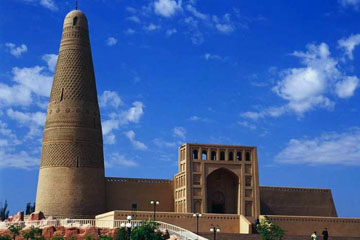
- Karez Irrigation System
After breakfast we will visit the ancient Karez Irrigation System, Local Uygur Family, Jiaohe Ruined, Sugong Minaret. After dinner you will take the soft sleeper train to Dunhuang.
Karez Irrigation System: The ancient Karez Irrigation System, which is still used today, is a unique irrigation system in Turpan. It takes advantage of the slopes, draws the underground water to flow by itself to irrigate farmland. It consists of four parts: vertical wells, underground channels, ground canals, and small reservoirs.
Local Uygur Family with Vineyard: Turpan is a kingdom of Grapes. All the local Uyghur families plant grapes at the back of their house. Local Uygur family visiting is a special experience for you to see their lifestyle in the fire-land.
Jiaohe Ancient City Ruins: The city's name means 'River City'. It was founded during the first century BC and abandoned during the 15th century. It is located atop a steep cliff on a leaf-shaped plateau between two deep river valleys in the Yarnaz valley 10 km to the west of Turpan City. It runs northwest to southeast, 1760 meters long and 300 meters across at the widest part. The ruins include city gates, streets and lanes, government office, temples, domestic houses, cave houses, wells, and an underground temple. It is part of the UNESCO World Heritage Silk Road Sites.
Sugong Minaret: Located in Mura Village 2km to the east of the city of Turpan, the minaret tower was built in the 41st year of the long reign of Qianlong Emperor during the Qing Dynasty. It is the embodiment of the ancient architectural arts of the Uighur people. The body of the tower is cylindroid in shape, built with bricks arranged in various symmetrical patterns on the outer wall. The tower has 14 windows and a spiral staircase inside going to the top.
Day 11
Dunhuang-
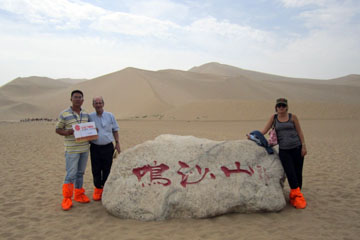
- Echoing-Sand Mountain
Our tour guide will receive you from the train station and check you into the hotel. We will then head to the Mogao Grottoes and Echoing-Sand Mountain.
Mogao Grottoes: The Mogao Grottoes, a shrine of Buddhist art treasures, is 25 km from downtown Dunhuang on the eastern slope of Mingsha Shan (Echoing Sand Mountain). A network of plank-reinforced roads plying north to south 1600 meters long lead to the cave openings, which are stacked five stories high, some reaching up to 50 meters. Incidentally, Mogao means high up in the desert. According to Tang Dynasty records, a monk had witnessed onsite a vision of thousand Buddhas under showers of golden rays. Thus inspired, he started the caves construction work that spanned a millennium, from the 4th to the 14th centuries. What remains today is truly awe inspiring, and is likely the world’s richest treasure house of Buddhist sutras, murals and sculptures. Please note that cameras are not allowed inside the grottoes.
Echoing-Sand Mountain and Crescent Lake: Together with the Crescent Spring and the Mogao Caves, the Echoing-Sand Mountain is the most popular tourist site in Dunhuang. Echoing-Sand Mountain, known as Mingsha Mountain to the Chinese, is 5 km to the south of Dunhuang and is famous for the constant sound of the moving sand. Legend has it that many years ago a horrific battle was fought here, and the sounds we hear today were the haunting cries of soldiers buried in the sand dunes. Situated within the Echoing-Sand Mountain Park, the Crescent Moon Lake is literally an oasis in the desert. The lake’s name derives from the crescent moon shape taken by the pool of spring water between two large sand dunes. Although the surrounding area is very dry, the pool surprisingly doesn’t dry up as one might expect.
Day 12
Dunhuang-

- The Jiayuguan Pass
In the morning we will head to Jiayuguan to visit the Jiayuguan Pass and The Great Wall on the Cliff. After dinner you will head to Lanzhou by soft sleeper train.
Jiayuguan Pass: Jiayuguan Pass stands in the southwest part of Jiayuguan City, about 6 km away from downtown. The Ming Dynasty fort here guards the strategic pass, at the western end of the Great Wall – this was the last section built by the Ming Dynasty. Construction of the fort was started in 1372 in the Ming Dynasty, and subsequently enlarged and strengthened, and was known as 'the strongest pass under heaven'. It is located in the Jiayu Highland, hence its name Jiayuguan. It is situated between the Wenshu and Heishan Mountains at the foot of Jiayuguan Hill of the Qilian Mountain range.
The Great Wall on the Cliff: The Suspended Wall is a part of the Great Wall of China. The wall here was built on the ridge with a gradient of 45 degrees. It is high in the air and it looks as if it fell down from the top of the hill. So people refer to this section of the Great Wall as the "Suspended Wall". The Suspended Wall, the extension of the walls at the Jiayuguan Pass towards the north, was an integral part of the ancient defense system at the Jiayuguan Pass.
Day 13
Lanzhou-

- Water Wheel Park
Our tour guide will receive you from the train station. We will then visit the Yellow River Mother Sculpture, Waterwheel Garden and White Pagoda Park. In the afternoon we will drive to Xining.
Yellow River Mother Sculpture: The Yellow River is revered by the Chinese as the mother of their civilisation. It runs right through Lanzhou, the capital of Gansu Province. The Yellow River Mother Sculpture is located on the south bank of Yellow River in the city of Lanzhou. The sculpture is 6 meters long and 2.6 meters in height, and weighs more than 40 tons. The sculpture comprises a mother and a baby, the mother with long hair, slim figure, lying on the undulating water looking happy and kind. Resting on her breast is a small child smiling naively. The Yellow River Mother Sculpture reflects the long history and culture of Gansu Province.
The Waterwheel Garden: The Waterwheel Garden was built in 1994, and is located on Binhe Middle Road in Lanzhou, Gansu Province. The garden covers an area of 1.45 hectares (3.58 acres) and is comprised of two waterwheels, a cofferdam, the recreation area and a water mill house.
White Pagoda Park: Located in the north part of Lanzhou City, the White Pagoda Park owes its name to the amazing White Pagoda within it. With images of Buddha on its eight sides, the seven-story pagoda with a height of 17 meters (about 55.8 feet), is pure white from top to bottom with the exception of the green top which greatly enhances the glamour of the whole building.
Day 14
Xining-

- Qinghai Lake and Bird
In the morning we will head to the Qinghai Lake and Bird Island, to enjoy the beautiful scene.
Qinghai Lake and Bird Island: This is the largest inland salt water lake in China. It is no exaggeration to say that Qinghai Lake is a miracle that is endowed by a deity. Outside, He encircled the lake with four continuous mountains and extends broad grassland at the foot of them. Inside, like a master baker, He decorated the water with many little islands. All these natural attractions come together perfectly to form a Xanadu on earth to win many tourists' favor. Shaped like an ellipse, Qinghai Lake lies northwest of the imposing Qinghai Altiplano, 150 km (93.21 miles) away from Xining in Qinghai Province. It reaches 28.71 m. (77.79 feet) at the deepest point but averages 19 meters (62.34 feet) overall. With an altitude of 3, 195 meters (10,482.28 feet), the climate surrounding the lake is very cool. Even in the middle of the summer, the average temperature in the daytime is about 15 C (59 F), which is why it is often selected as a summer resort
Day 15
Xining-

- Kumbum Monastery
We will visit the Kumbum Monastery (Ta'er si), then take the soft sleeper train to Lhasa, Tibet.
Kumbum Monastery: Located 26km south of the Xining city proper, the sacred Kumbum Monastery, or Ta'er Si, is the best of the sights in the Xining area. The ancient monastery, built during the 39th year (1560 AD) of the reign of emperor Jiajing of Ming Dynasty, boasts a Tibetan name, Kumbum, which means a grand place housing 100,000 Buddhas. The sight is most sacred due to the personages who have graced it with their presence. It was originally built upon the birth place of the founder of the Gelukpa Sect (Yellow Hat) of Tibetan Buddhism, Tsong Khapa. Two of his disciples from this region also went on to become famous in the Buddhist world, one becoming Dalai Lama, the other the Panchen Lama, both great living Buddhas. The present Dalai Lama, now in exile in India, also studied and lived here.
Day 16
Tibet-

- Barkor Circuit
We will check into the hotel upon arrival and rest to acclimatise to the high altitude. We will later enjoy wandering through a market at Barkor Circuit.
Barkor Circuit: Located in the old area of Lhasa City, Tibet, Barkor Street is a very ancient round street surrounding the Jokhang Temple and the Tibetan people are always proud of it. As a symbol of Lhasa, this street is also a must-see place for the tourists. It's said that in 647, the first Tibetan King Songtsen Gampo (617 - 650) built the Jokhang Temple. Due to its magnificence, it quickly attracted thousands of Buddhist pilgrims. As a result, a trodden path appeared. That is the origin of Barkor Street.
Day 17
Tibet-
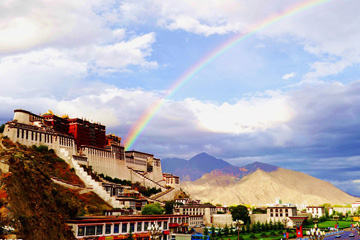
- Polata Palace
We will visit the world-famous architectural wonder -the Potala Palace, which towers over the entire mountains and the lake below, is simple gorgeous. This is where the Dalian Lama spent his winters. We will also visit the Jokhang Temple, which is known as the most sacred place in Tibet - thousands of Pilgrims from all over Tibet come here to pay homage.
Potala Palace: Situated on the Red Hill of central Lhasa, Potala Palace is the highest ancient palace in the world, reaching 3,767m (12,359ft) at the topmost point. Potala, named after a holy hill in South India, is a Sanskrit word meaning "Abode of the Avalokitesvara (Buddha of Mercy)". Legend has it that in the 7th century, to greet his bride Princess Wen Cheng of the Tang Dynasty (618B.C. - 907B.C.) of China, the then Tibet King Songtsen Gampo built a 9-storey palace with a thousand rooms up on the Red Hill and named it Potala. Later, with the collapse of the Songtsen Gampo Dynasty, the ancient palace was almost destroyed in wars.
Day 18
Lhasa-

- Yamdrok Lake
We will enjoy a scenic drive to one of Tibet's holy lakes -Yamdrok Lake . It is a sparking turquoise lake flanked by snow-capped peak. On the way you will see local nomad camps, herd of yak and sheep and beautiful mountains scenery before arriving at Gyantse.
Yamdrok Lake: Yamdrok Lake is one of the three largest sacred lakes in Tibet. It is over 72 km (45 miles) long. The lake is surrounded by many snow-capped mountains and is fed by numerous small streams. The lake does have an outlet stream at its far western end. Around 90km to the west of the lake lies the Tibetan town of Gyantse and Lhasa is a hundred km to the northwest. According to local mythology, Yamdrok Lake is the transformation of a goddess. Yamdrok Lake has a power station that was completed and dedicated in 1996 near the small village of Pai-Ti at the lake’s western end. This power station is the largest in Tibet. The lake with an area of 621 square kilometers and unknown depth is fan-shaped, spreading to the South but narrowing up to the North. The mountainous lake has a dozen of islands, the largest of which is about 3,000 square kilometers. The lake freezes up in winter. Like mountains, lakes are considered sacrosanct by the Tibetan people, the principle being that they are the dwelling places of protective deities and therefore invested with special spiritual powers.
Day 19
LhasaAfter breakfast we will check out of the hotel, and your journey ends with an airport transfer.
| Travel in party of |
Superior Class ★★★★★ |
Deluxe Class ★★★★ |
Tourist Class ★★★ |
| 2-5 persons | N | $ | $ |
| 6-9 persons | N | $ | $ |
| 10 persons & above | N | $ | $ |
| Single room Supplement | N | $ | $ |
Service included:
√ Breakfast in the hotel
√ Personal Guide & Driver + Private car / van for Private Transfers & sightseeing
√ Hotels with breakfast(twin share bases) as listed in the itinerary .
√ Domestic flights or trains as listed in the itinerary
√ Airport Taxes: US$30for domestic,
√ Service Charge & Government Taxes .
√ Luggage Transfers between airports and hotels
√ Goverment letter for visa support
Service excluded:
* Personal expenses, tips to the guide and driver
* Other activities such as boating, camel riding ect






